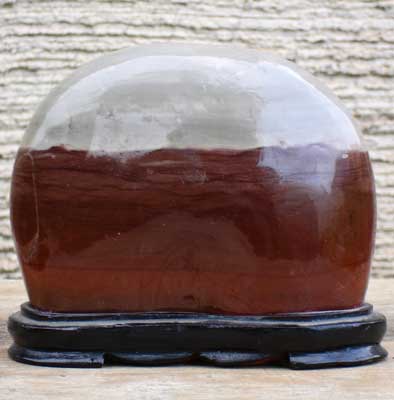
Silver, gold, and diamonds are not the only precious stones that can be considered treasures. Connoisseurs of art and landscaping have discovered a new kind of precious stone, the suiseki.
Unlike diamonds, however, the suiseki is naturally-carved. It’s after all, a natural stone that features unusual markings and rare shapes that haven’t been tampered by man.
Suiseki is coined from two Japanese words, “sui” for water, and “seki” for stone. It is also derived from “sansui-seki,” meaning stone with a total landscape, scenery or depiction of an object. The latter can include animals, plants, human beings, and popular figures, among many others. Eventually, the word was shortened into what we call now as “suiseki.”
This rock is also known as the mountain stone or viewing stone. It is often used as a complimentary object for bonsai plants. Sometimes, it is the bonsai that serves as the secondary object, especially when the suiseki stone being used is considered valuable.
The art of suiseki is an allied art to bonsai, and most bonsai growers also collect these stones. As with the art of bonsai, the suiseki originated from China. It was then introduced in Japan by the Buddhist monks in the 15th century.
Today, the art of suiseki collecting has emerged into a hobby not only in Asia, but also in America, Australia, Europe, and the Middle East.
The suiseki is stationary or motionless, quiet and calm, which is a sharp contrast to the bonsai which can grow and propagate. A bonsai can also be designed by man while the suiseki’s “point of interest” has to be discovered. It is this concept or feeling that makes one appreciate this culture in which the mind imagines the beautiful things the stone has revealed.
The stone must be displayed in a manner that will enhance its features. For instance, it would be apt to fit the stone in a wooden flat stand that may be round, oval, or irregular. It depends on the stone’s shape. The bottom may be cut or ground to fit its base but one must never tamper, add or subtract the stone’s natural texture, color, or form.
Likewise, if one wishes to depict the stone as an island, he can place the stone in a shallow tray filled with water or fine white sand. But never add anything to this scenery. The philosophy is to leave it to the viewer to exercise his imagination or interpretation.
As with shopping for diamonds, suiseki collectors need to consult with experts to appraise the stone’s value and to check if it has been tampered with.
Suiseki stones are classified under three classes; first, second, or third class. First class stones can clearly represent a snow-peaked mountain, a waterfall, an animal (not fossil), and even the likeness of a famous person with prominent features. American President Abraham Lincoln, for instance, comes to mind. Second and third class stones feature hieroglyphic-like designs.
A Korean suiseki expert has listed the following considerations in evaluating a suiseki stone:
•The real jet black color is considered rare and is highly-coveted.
•As to the weight, the stone should be heavy or heavier as compared to most stones found in the area.
•The sheen, it should have a natural gloss and not enhanced by chemicals or other materials.
•Stones in other colors can also be valuable for as long as they can vividly represent an animal or object sans the addition of wood or any material. In other words, you have to leave it to the imagination of the viewers to visualize the object without any suggestion as to what is it supposed to be.
“The rock can be easily called a suiseki if nine out of 10 viewers can easily recognize the representation. If the viewers of a particular stone have many different interpretations or opinions and do not agree on a common idea, then that stone is worthless.”
•Not considered as suiseki stones are gem stones like opal, jade, quarts, diamond, amethyst, topaz, ruby, emerald, and the like. So are the corrals, stalactites, stalagmites, petrified rocks, and fossils.”
Source: www.mb.com.ph




